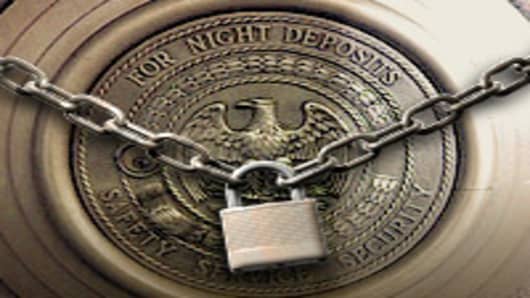Wells Fargo (WFC) shocked the market Thursday when it revealed that it earned $3 billion in the first quarter. (Yes, that was after announcing $3.3 billion in write-offs, but hey, who's counting?) While signs of post-TARP animation from any of the big players are comforting, the fact is that there are plenty of banks that are holding their own or even gaining ground, even in today's dismal economic climate. Chris Whalen of Institutional Risk Analytics, a company that monitors bank performance, says there are thousands of banks in the United States that aren't in danger of failing, which tends to get overlooked by the media attention focused on the 250 or so that need a lifeboat.
What makes a bank less bad in this climate? Formulas for figuring out the health of other types of businesses (like manufacturing or retail) can't be usefully applied to banks because these firms tend to be so highly leveraged. In theory, you could look at a capital-to-asset ratio or a liabilities-to-asset ratio. The hitch with both of these, of course, is that many banks today are carrying assets that are hard to value because there's no market for them anymore.
There are a few big-picture indications that can help paint a picture of a bank's relative robustness. Analysts also like banks that focus their business on lending. Despite the mortgage mess, writing loans is still safer than managing securities portfolios and trading derivatives and other exotic instruments. If a bank's spent the past few years bolstering its position this way, there's a pretty good chance that at least some of those deals will have some nasty creepy-crawlies underneath if you lift them up and take a peek.
Sometimes, it's a size thing. Many currently healthy banks are regional or community institutions that were never really big enough to run with the fast crowd, so they never got involved in the high-stakes derivatives trading that brought down the higher-profile institutions.
In some cases, a smaller geographic footprint helps. Banks with sizable offshore operations have to divert resources to feed those hungry stepchildren. Domestically, regional banks in areas hard-hit by mortgage defaults, like Florida, Nevada, and parts of California, probably have more risk on their books than those in other parts of the country.
TBM talked to market watchers and number crunchers to come up with a short list of banks notable for how far they haven't fallen.
BB&T: In a season when cutting dividends is the new black, just holding steady at 47 cents per share was enough to make BB&T (BBT) stand out from the pack. Though there's been a bit of controversy as to whether a TARP recipient (BB&T took $3.1 billion from the government) should be sharing the wealth, analysts point out that handing capital to banks like the North Carolina-based BB&T puts them in a position to absorb smaller, weaker banks that might otherwise die on the vine.
Beal Bank: Texas-based and privately owned, this bank is a bit of an odd duck, as Forbes pointed out in a recent profile of Beal's eponymous, poker-playing, libertarian founder. Beal (the bank, not the man) is kind of like the gawky AV-club member at the prom who turns up at the reunion with a Rolex on one arm and a blonde on the other. The bank effectively sat out the credit boom entirely, putting the brakes on its standard MO of gobbling up loans on the secondary market just when everyone else was clamoring to get in the game. In 2008, Beal turned out an eye-popping 8.1 return on assets ratio (a number in the range of 1 to 1.5 is considered good). What looked staid and unsexy during the boom years turned out to be a pretty good bet after all.
_____________________________________
More From The Big Money:
- Little House on the Foreclosure Belt
- The War the Rich are Waging...Against the Rich
- The Bursting of the Spa Bath Bubble
_____________________________________
Hudson City Bancorp (HCBK): This bank is an industry pace car; its so-called "stress level," which takes into account factors like its loan defaults and lending capacity, has been nearly flat over the past two years. Looking at Hudson City's numbers in a vacuum, no one would suspect the current level of market turmoil. While its percentage of nonperforming loans has risen to just less than 1 percent as of last month, that's still well below the industry standard. What's more, Hudson City never so much as dipped a toe into exotic derivatives like the credit-default swaps that were the downfall of so many. Maybe this New Jersey bank took to heart the ongoing lesson of The Sopranos: Chasing after the easy money can get you whacked.
Signature Bank (SBNY): Despite being headquartered a scant few miles from the wreckage of Wall Street, this New York-based bank has managed to stay above the fray. Although bigger players like Goldman Sachs and Bank of America have announced that they're planning to return TARP money ... eventually, Signature was among the first to put its money where its mouth was, giving back $120 million earlier this month. It's in a stronger position than many of its peers because that TARP infusion came just after Signature raised $148 million in a public offering.


